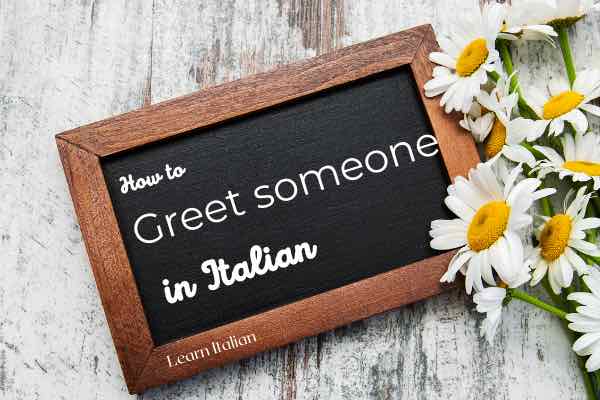
How to say hello in Italian
Learn how to say hello in Italian and the correct way to greet someone in Italian in person over the phone.
There are several ways to hello in Italian.
How to greet someone in Italian depends on the relationship you have with them, possibly the time of day and the specific circumstances of your encounter.
Today, we will have a look at the most common ways to say hello in Italian and Italian greetings you may use or hear while in Italy.
This post is part of our series ‘lear Italian’ – find all lessons HERE.
How to greet someone in Italian
Hello in Italian – informal
The informal and most common way to say hello in Italian is ‘ciao’ (pron. cha-oh)
The word is used all over Italy and it is the standard greening when you see a friend.
Ciao is an informal greeting: you use it when you meet a person you know well, a child or you may hear it between young people or when an older person addressed a child or a teenager.
You should not use ‘ciao’ when addressing an adult you don’t know and you should not use it at a cafe’ or restaurant to greet your waiter, unless you are a regular customer or at the end of a meal when you have stricken an amicable conversation with them.
Need to know! You may hear people say ‘ciao bella‘ or ‘ciao bello‘ which literally translates into ‘hello beautiful’ or even ‘hello dear’. These greetings are used between friends but should not be used with a person you do not know. Do not say ‘ciao bella‘ to a woman thinking it is flattering. Exactly like in English, saying ‘hello beautiful’ to a woman may well make her uncomfortable and it is something you see in movies portraying a cliche’ Italy more than what people actually say.
Hello in Italian – formal
A more formal way to say hello in Italian and the Italian word for hello you will use the most on your travels is ‘buongiorno‘.
Buongiorno literally translates into ‘good day’ but you can use it almost any time of day, with the exception of the evening when you would use Buona sera instead (see below).
Buongiorno is a a good passepartout word to know. It is appropriate when you do not know the person you are greeting (this includes a hotelier or waiter) but it stays appropriate also when you see someone regularly but do not know them well.
For instance, if you are staying in a hotel for a week, even if you deal with the same staff member every day, it is appropriate to keep the greeting ‘buongiorno’, instead of switching to the most informal (and in this case possibly patronizing) ‘ciao’.
Good to know: Italian also has the expression ‘buon pomeriggio’ lit. ‘Good afternoon. The expression is common however, it is not a greeting when you meet someone but a way to part from someone. So if you leave a cafe in the afternoon after a meal you will say ‘grazie, buon pomeriggio’ which is the equivalent of ‘Thank you, have a nice day’.
Hello in Italian (evening greeting) – formal
The formal and polite way to greet someone in the evening is ‘Buona sera’. This expression literally translates into ‘good evening’ and it is used the same way as the English equivalent.
If you enter a restaurant for dinner, the correct greeting would be: Buonasera, ha un tavolo per quattro, per favore?’ Lit: Good evening, would you have a table for four, please?’
Good to know: you use buonasera to greet people after dark even if late at night. The expression ‘Buona Notte’ exists in Italian but, like in English, it is a parting expression used to wish someone a good night.
Learning Italian for an upcoming trip? Then you will love our free guide to travelers’ Italian, packed with over 100 Italian words and expressions you can use on your Italian vacation.
Other Italian greetings you may hear
Salve – Salve comes from Latin and it is a formal greeting you often see in writing especially.
It is not uncommon for an info request email for instance to start with a ‘Salve, vorrei sapere se …” which translates into ‘hello, I’d like to know if…’
You may also hear it occasionally in the spoken language in an exchange such as the following:
A. Buongiorno, come sta? Hello, how are you? (Formal)
B. Salve! Bene grazie, lei? Hello, I am doing well, thank you, how about you? (Formal)
Buondi’ – a different form of Buongionrno (di’= giorno), this is an unusual greeting although you may very occasionally hear it (it is also the name of a popular packaged cake for kids!)
How to part from someone in Italian
There are many ways to say goodbye in Italian.
Ciao – goodbye (informal)
Italian uses ciao both when greeting someone and when parting from someone informally.
Arrivederci – goodbye (formal)
Like Buogniorno, this is an excellent passepartout word to politely leave someone.
A presto – see you soon (both formal and informal )
This can be used also or in conjunction with ciao or arrivederci.
Buona giornata – have a good day
This can be used in conjunction with ciao or arrivederci.
Buona serata – have a good evening
Searata in another way to say sera but the expression buona serata is different from buona sera. While buona sera is a greeting, buona serata translates into ‘have a good evening’.
If you are going out for dinner, the taxi driver dropping you off you may see you off saying: buona serata.
In writing, you may also find different expressions such as:
Cordiali saluti, Cordialmente, Saluti – these are usually only used in writing.
How to say hello in Italian on the phone
In Italian, we do not use the quivalent of hello when answering the phone, but the word ‘pronto’. Pronto means ready and it is used when picking up the phone like in the example below:
You pick up the phone and say: pronto? Hello?
The caller: pronto buongiorno, parlo con…? Hello, hi, am I speaking with…
I hope you found this essential guide to Italian greetings useful!
Don’t forget you can find many more useful Italian phrases for tourists here.
How to say hello in Italian: pint this!





